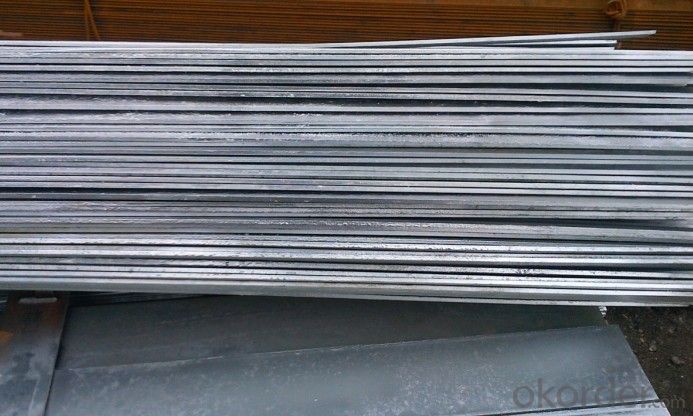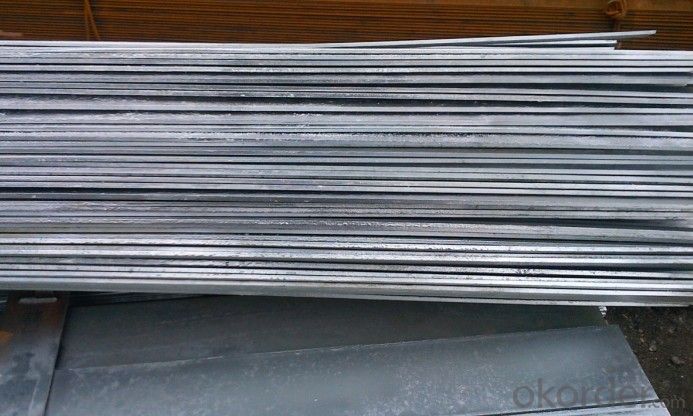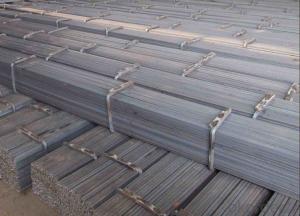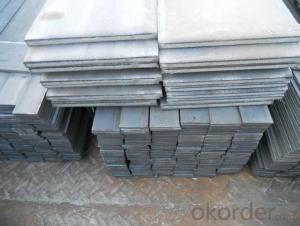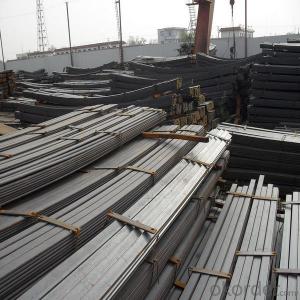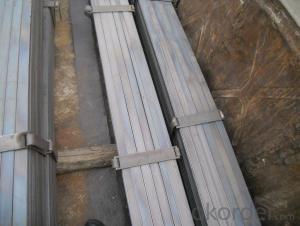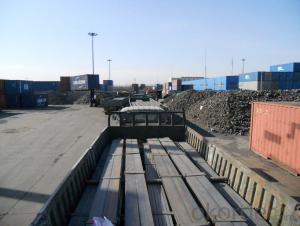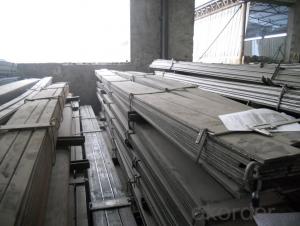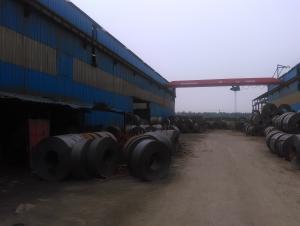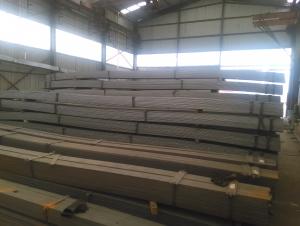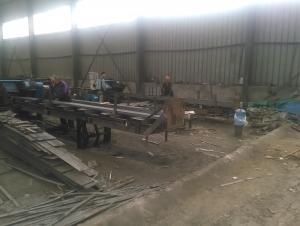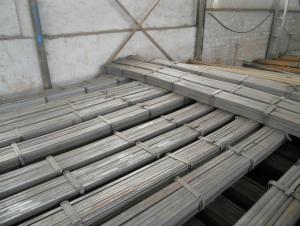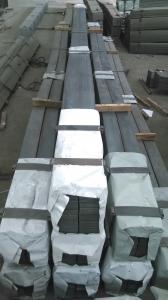Carbon Steel Flat Bar Cold Drawn Made in China for Sale
- Loading Port:
- China main port
- Payment Terms:
- TT or LC
- Min Order Qty:
- 50 m.t.
- Supply Capability:
- 10000 m.t./month
OKorder Service Pledge
OKorder Financial Service
You Might Also Like
Specifications of Steel Round Bar Cold Drawn with High Qaulity for Construction:
Commodity: Carbon Steel Flat Bar
Standard: GB, JIS, ASTM,
Material: Q235, SS400 or Equivalent
Brand name: FLATSPACE
Origin place: China
Thickness: 3mm-30mm
Width:20mm-200mm
Length: Max 12m
Certification: SGS/BV
Chemical composition
Alloy No | Grade | Element(%) | ||||
C
| Mn
| S
| P
| Si
| ||
Q235
|
B
|
0.12—0.20 |
0.3—0.7 |
≤0.045 |
≤0.045
|
≤0.3
|
Physical properties
Alloy No | Grade | Yielding strength point(Mpa) | Tensile strength (Mpa) | Elongation after fracture(%) | ||||||
Thickness (mm) | Thickness (mm) | |||||||||
≤16 | >16--40 | >40--60 | >60--100 | ≤16 | >16--40 | >40--60 | >60--100 | |||
≥ | ≥ | |||||||||
Q235 |
B |
235 |
225 |
215 |
205 |
375--500 |
26 |
25 |
24 |
23 |
Above sheets show the technical data of Q235,we can also provide other materials similar to Q235.
Applications of Steel Round Bar Cold Drawn with High Qaulity for Construction:
Widely used for construction;
Machinery manufacturing;
Iron tower steel structure;
Shipbuilding; Steel grating;
Staircase;
Bridge;
Viaduct;
Railway spare parts;
Boilers making etc.
Packaging & Delivery of Steel Round Bar Cold Drawn with High Qaulity for Construction:
Packaging Details: The Steel Flat Bars are packed in bundles and loaded in 20 feet/40 feet container, or shipped by bulk cargo ,also we can do as customer's requirements.
Delivery Details:30~45 days upon the receipt of buyer payment by T.T. or L/C.
Production Flow of Steel Round Bar Cold Drawn with High Qaulity for Construction:
The Carbon Steel Flat Bar is made through three processes:
1.Feeding the material: Feeding the row material (the steel plate) to Slitting Line.
2.Slitting:The steel plate would be slitted into expected width by lengthways cutter.
3. Leveled and cutting: The plat bar would be ground into level by the grinder and then cut into required length.
FAQ:
Q1: Why buy Materials & Equipment from OKorder.com?
A1: All products offered byOKorder.com are carefully selected from China's most reliable manufacturing enterprises. Through its ISO certifications, OKorder.com adheres to the highest standards and a commitment to supply chain safety and customer satisfaction.
Q2: How do we guarantee the quality of our products?
A2: We have established an advanced quality management system which conducts strict quality tests at every step, from raw materials to the final product. At the same time, we provide extensive follow-up service assurances as required.
Q3: How soon can we receive the product after purchase?
A3: Within three days of placing an order, we will begin production. The specific shipping date is dependent upon international and government factors, but is typically 7 to 10 workdays.
Images:

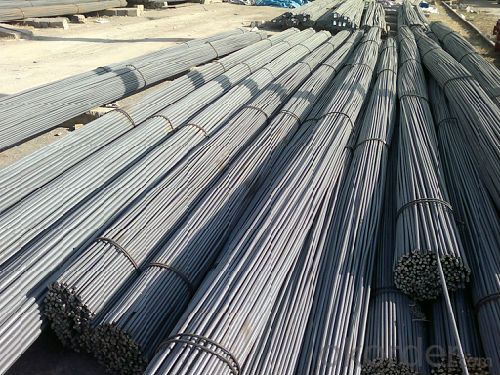
- Q: What are the common methods of cutting steel flat bars?
- There are several common methods used for cutting steel flat bars. 1. Manual cutting: This method involves using hand tools such as hacksaws or bolt cutters to cut through the steel. It is a slower and more labor-intensive process, but it is suitable for small-scale projects or when access to power tools is limited. 2. Abrasive cutting: This method utilizes abrasive wheels or discs to grind through the steel. It is commonly done using a handheld angle grinder or a stationary abrasive saw. Abrasive cutting is relatively quick and efficient, but it may produce a rougher edge that may require further finishing. 3. Band saw cutting: Band saws equipped with metal-cutting blades are commonly used for cutting steel flat bars. This method allows for more precise and accurate cuts, especially for larger or thicker bars. Band saws come in various sizes, including portable options for on-site cutting or larger industrial models for heavy-duty cutting. 4. Plasma cutting: Plasma cutting involves using a high-velocity jet of ionized gas, or plasma, to melt through the steel. This method is known for its speed and versatility, as it can cut through various thicknesses of steel and produce clean and precise cuts. Plasma cutting machines are commonly used in industrial settings. 5. Laser cutting: Laser cutting uses a high-powered laser beam to melt and vaporize the steel, resulting in a precise and smooth cut. This method is highly accurate and can produce intricate designs or patterns. However, laser cutting machines can be expensive and are typically used in specialized fabrication shops or manufacturing facilities. It is important to consider factors such as the desired cut quality, accuracy, speed, and available resources when choosing the appropriate method for cutting steel flat bars.
- Q: How do you store and transport steel flat bars safely?
- To ensure the safe storage and transportation of steel flat bars, it is essential to follow several important steps: 1. Stack the bars correctly: Proper stacking is crucial in preventing damage. Align each layer of bars horizontally and evenly, distributing the weight evenly across the stack to maintain its structural integrity. 2. Provide adequate support: Prevent sagging or bending of the bars by using sturdy supports such as appropriately sized pallets or racks. Ensure that the supports can handle the weight and size of the bars. 3. Secure the stack: To avoid shifting during transportation, securely fasten the stack with straps or bands. Make sure they are tightly fastened, ensuring that the bars remain in place throughout transit. 4. Take protective measures: Steel flat bars are vulnerable to corrosion, especially when exposed to moisture. Protect them from environmental elements during storage and transportation by using protective covers or wrapping the bars in moisture-resistant materials to prevent rust or damage. 5. Use proper lifting and handling techniques: When moving the bars, employ suitable lifting equipment like forklifts or cranes to prevent accidents or injuries. Ensure that the equipment is capable of handling the weight of the bars and that operators are trained in safe lifting practices. 6. Considerations for long-distance transportation: If transporting the bars over long distances, it may be necessary to utilize specialized shipping containers or trucks equipped to handle heavy loads and provide adequate protection from external elements. By adhering to these guidelines, you can minimize the risk of damage, accidents, and corrosion, ensuring the safe delivery of steel flat bars to their intended destination.
- Q: How do you cut steel flat bars to a specific length?
- To cut steel flat bars to a specific length, you can use various tools such as a hacksaw, circular saw, or angle grinder equipped with a cutting disc suitable for metal. Measure the desired length accurately using a measuring tape or ruler, and mark the cut line on the steel bar. Secure the bar firmly in a vise or clamp to prevent any movement while cutting. Then, carefully follow the marked line and use the selected cutting tool to make a smooth and straight cut through the steel flat bar.
- Q: Earthing flat steel and earthing main line
- Grounding flat ground belongs to the material, the grounding line belongs to the grounding line, grounding flat steel used for grounding grid, the grounding line is also one of the flat ground, for connecting the grounding grid, the grounding grid extends to the metal shell of the substation ground of all electrical equipment, and the grounding grid connected together.
- Q: Are steel flat bars suitable for making brackets or supports for recreational equipment?
- Yes, steel flat bars are suitable for making brackets or supports for recreational equipment. Steel is a strong and durable material that can provide the necessary support and stability for various recreational equipment. The flat bars can be easily welded or bolted together to create custom brackets or supports that can withstand heavy loads and provide the necessary structural integrity. Additionally, steel is resistant to corrosion, which is particularly important for outdoor and water-related recreational activities. Overall, steel flat bars are a reliable choice for making brackets or supports for recreational equipment.
- Q: How do steel flat bars differ from steel round bars?
- Steel flat bars and steel round bars differ in their shape and structural properties. The most obvious difference between steel flat bars and steel round bars is their shape. Steel flat bars are characterized by their rectangular shape with sharp edges and a flat surface on the top and bottom. On the other hand, steel round bars have a circular cross-section, resembling a rod or a cylinder. In terms of structural properties, steel flat bars and steel round bars also vary. Steel flat bars are often preferred for applications that require a high load-bearing capacity in a horizontal direction, such as supporting weight or providing structural stability. Their flat surface allows for better distribution of weight and helps prevent bending or warping under heavy loads. Steel round bars, on the other hand, are commonly used in applications that require strength and durability in various directions, including vertical and horizontal forces. The circular shape of round bars provides excellent resistance to bending and twisting, making them suitable for applications such as construction, machinery, and automotive components. Additionally, the manufacturing process for steel flat bars and steel round bars may also differ. Steel flat bars are typically produced by hot rolling, which involves passing heated steel through a series of rollers to achieve the desired shape. Steel round bars can be produced by both hot rolling and cold drawing processes, where the steel is either heated and passed through rollers or pulled through a die to form the circular shape. In summary, steel flat bars and steel round bars differ in terms of shape, structural properties, and manufacturing processes. Understanding these differences is crucial when selecting the appropriate steel bar for a specific application.
- Q: Is the earthing electrode made of galvanized flat steel or bare copper wire?
- The combination of conductors or conductors that are buried in the earth so as to connect with the earth is called a ground electrode. The grounding electrode is the electrode which is in full contact with the ground and realizes the connection with the earth. In the electrical engineering, the grounding electrode is made of a plurality of 2.5M long, 45X45mm galvanized steel angles, and is nailed at the bottom of the 800mm deep groove, and then is drawn out with the lead out line.
- Q: What is the tensile strength of a steel flat bar?
- The tensile strength of a steel flat bar can vary depending on the specific grade and manufacturing process. However, in general, steel flat bars are known for their high tensile strength. Tensile strength refers to the maximum amount of tensile stress that a material can withstand before it breaks or fails. Steel flat bars are typically made of carbon steel, which has a high tensile strength. The exact tensile strength can vary, but it is typically in the range of 400 to 700 megapascals (MPa). It is important to note that the tensile strength can also be influenced by factors such as the thickness and width of the flat bar, as well as any additional heat treatment or alloying elements that may be present in the steel. Therefore, it is recommended to refer to the specific grade and manufacturer's specifications for accurate and precise tensile strength values.
- Q: Can steel flat bars be used in the manufacturing of machinery?
- Yes, steel flat bars can be used in the manufacturing of machinery. Steel flat bars are commonly used in the construction of machinery components due to their strength, durability, and versatility. They can be shaped, cut, and welded to create various machine parts such as brackets, supports, frames, and structural elements. Additionally, steel flat bars offer good resistance to impact, wear, and corrosion, making them suitable for industrial applications in the manufacturing sector.
- Q: Are steel flat bars suitable for architectural metalwork?
- Yes, steel flat bars are suitable for architectural metalwork. They are versatile and commonly used in various architectural applications such as framing, support structures, decorative elements, and trim work. With their strength, durability, and ability to be easily shaped and welded, steel flat bars provide architects and designers with a reliable material option for creating aesthetically pleasing and functional architectural features.
Send your message to us
Carbon Steel Flat Bar Cold Drawn Made in China for Sale
- Loading Port:
- China main port
- Payment Terms:
- TT or LC
- Min Order Qty:
- 50 m.t.
- Supply Capability:
- 10000 m.t./month
OKorder Service Pledge
OKorder Financial Service
Similar products
Hot products
Hot Searches
Related keywords




